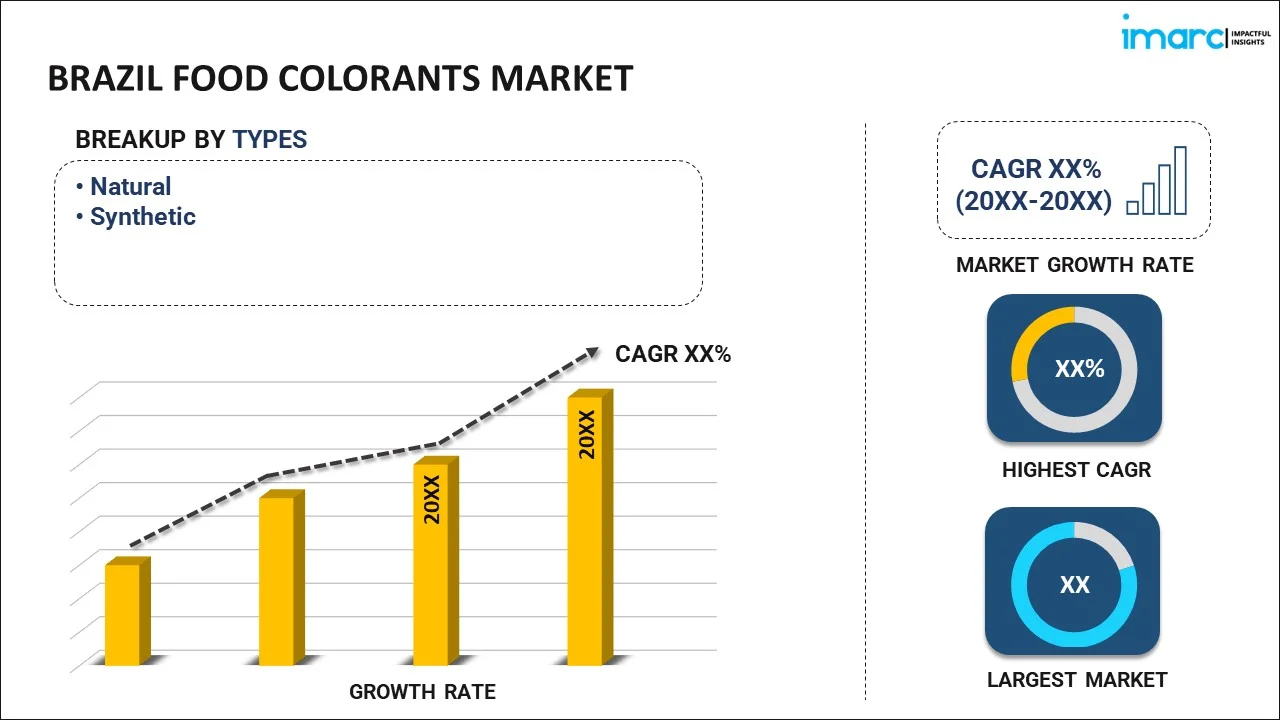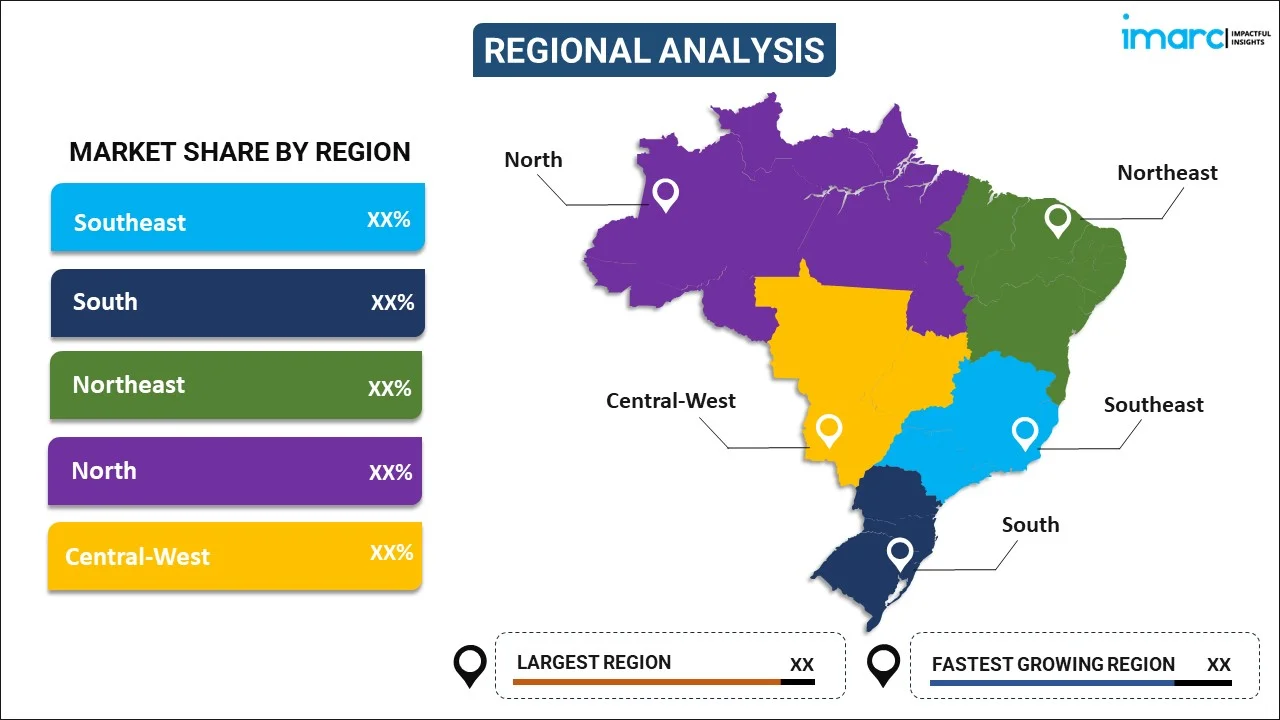
Brazil Food Colorants Market Report by Type (Natural, Synthetic), Application (Meat Products, Bakery, Dairy, Beverages, Confectionery, and Others), and Region 2024-2032
Market Overview:
Brazil food colorants market size is projected to exhibit a growth rate (CAGR) of 3.56% during 2024-2032. The increasing influence of global food culture, growing emphasis on sustainability, significant technological advancements in food processing and colorant formulation, culinary diversity, and emerging trend toward health-conscious consumption, and favorable regulatory environment represent some of the key factors driving the market.
|
Report Attribute
|
Key Statistics
|
|---|---|
|
Base Year
|
2023 |
|
Forecast Years
|
2024-2032
|
|
Historical Years
|
2018-2023
|
| Market Growth Rate (2024-2032) | 3.56% |
Food colorants are substances used to enhance or modify the appearance of food products. They play a pivotal role in making food items visually appealing, which often influences consumer choices. These colorants are added to a wide array of products, including beverages, confectionery, baked goods, and even meat, to either restore color lost during processing or to introduce a new hue. Food colorants are broadly categorized into natural and artificial types. Natural colorants are derived from plants, minerals, and animals. For instance, beta-carotene, extracted from carrots, is commonly used to impart an orange hue, while beet juice provides a red or pink shade. Artificial colorants, on the other hand, are chemically synthesized and are generally more vibrant, stable, and cost-effective as compared to their natural counterparts. Regulatory agencies closely monitor the use of food colorants to ensure they meet safety standards. These organizations assess the toxicity, allergenicity, and carcinogenicity of colorants to confirm their safety for consumption.
Brazil Food Colorants Market Trends:
Changing consumer preferences represents one of the key factors driving the growth of the market across Brazil. The expanding middle class base in Brazil is becoming more discerning in their food choices, showing a preference for visually appealing food products. This drives the need for food colorants, both natural and artificial. The increasing influence of global food culture in Brazil, due to globalization and digital media, is raising interest in a variety of international cuisines that often require the use of colorants. An emerging trend toward health-conscious consumption is acting as a major growth-inducing factor. Consumers are scrutinizing labels for artificial additives and are more willing to pay a premium for natural ingredients. The Government of Brazil and food safety organizations are gradually aligning local regulations with international guidelines. This is implicating for the food colorants market as it mandates the use of approved and safe additives. Technological advancements in food processing and colorant formulation are leading to the creation of more stable and vibrant colors that can withstand various environmental factors like heat and light. Brazil's rich culinary tradition and varied diet provide a fertile ground for the application of food colorants in everything from traditional dishes to novel food products. Brazil's food exports necessitate the use of colorants that meet international standards. The need to maintain or enhance the visual appeal of food products for exportation is a key driver. The growing emphasis on sustainability is leading to a rise in the demand for eco-friendly colorants derived from sustainable sources, which is creating a positive outlook for the market across the country.
Brazil Food Colorants Market Segmentation:
IMARC Group provides an analysis of the key trends in each segment of the market, along with forecasts at the country level for 2024-2032. Our report has categorized the market based on type and application.
Type Insights:

- Natural
- Synthetic
The report has provided a detailed breakup and analysis of the market based on the type. This includes natural and synthetic.
Application Insights:
- Meat Products
- Bakery
- Dairy
- Beverages
- Confectionery
- Others
A detailed breakup and analysis of the market based on the application have also been provided in the report. This includes meat products, bakery, dairy, beverages, confectionery, and others.
Regional Insights:

- Southeast
- South
- Northeast
- North
- Central-West
The report has also provided a comprehensive analysis of all the major regional markets, which include Southeast, South, Northeast, North, and Central-West.
Competitive Landscape:
The market research report has also provided a comprehensive analysis of the competitive landscape in the market. Competitive analysis such as market structure, key player positioning, top winning strategies, competitive dashboard, and company evaluation quadrant has been covered in the report. Also, detailed profiles of all major companies have been provided.
Brazil Food Colorants Market Report Coverage:
| Report Features | Details |
|---|---|
| Base Year of the Analysis | 2023 |
| Historical Period | 2018-2023 |
| Forecast Period | 2024-2032 |
| Units | US$ Million |
| Scope of the Report | Exploration of Historical and Forecast Trends, Industry Catalysts and Challenges, Segment-Wise Historical and Predictive Market Assessment:
|
| Types Covered | Natural, Synthetic |
| Applications Covered | Meat Products, Bakery, Dairy, Beverages, Confectionery, Others |
| Regions Covered | Southeast, South, Northeast, North, Central-West |
| Customization Scope | 10% Free Customization |
| Report Price and Purchase Option | Single User License: US$ 3699 Five User License: US$ 4699 Corporate License: US$ 5699 |
| Post-Sale Analyst Support | 10-12 Weeks |
| Delivery Format | PDF and Excel through Email (We can also provide the editable version of the report in PPT/Word format on special request) |
Key Questions Answered in This Report:
- How has the Brazil food colorants market performed so far and how will it perform in the coming years?
- What has been the impact of COVID-19 on the Brazil food colorants market?
- What is the breakup of the Brazil food colorants market on the basis of type?
- What is the breakup of the Brazil food colorants market on the basis of application?
- What are the various stages in the value chain of the Brazil food colorants market?
- What are the key driving factors and challenges in the Brazil food colorants?
- What is the structure of the Brazil food colorants market and who are the key players?
- What is the degree of competition in the Brazil food colorants market?
Key Benefits for Stakeholders:
- IMARC’s industry report offers a comprehensive quantitative analysis of various market segments, historical and current market trends, market forecasts, and dynamics of the Brazil food colorants market from 2018-2032.
- The research report provides the latest information on the market drivers, challenges, and opportunities in the Brazil food colorants market.
- Porter's five forces analysis assist stakeholders in assessing the impact of new entrants, competitive rivalry, supplier power, buyer power, and the threat of substitution. It helps stakeholders to analyze the level of competition within the Brazil food colorants industry and its attractiveness.
- Competitive landscape allows stakeholders to understand their competitive environment and provides an insight into the current positions of key players in the market.
Need more help?
- Speak to our experienced analysts for insights on the current market scenarios.
- Include additional segments and countries to customize the report as per your requirement.
- Gain an unparalleled competitive advantage in your domain by understanding how to utilize the report and positively impacting your operations and revenue.
- For further assistance, please connect with our analysts.
 Inquire Before Buying
Inquire Before Buying
 Speak to an Analyst
Speak to an Analyst
 Request Brochure
Request Brochure
 Request Customization
Request Customization




.webp)




.webp)












